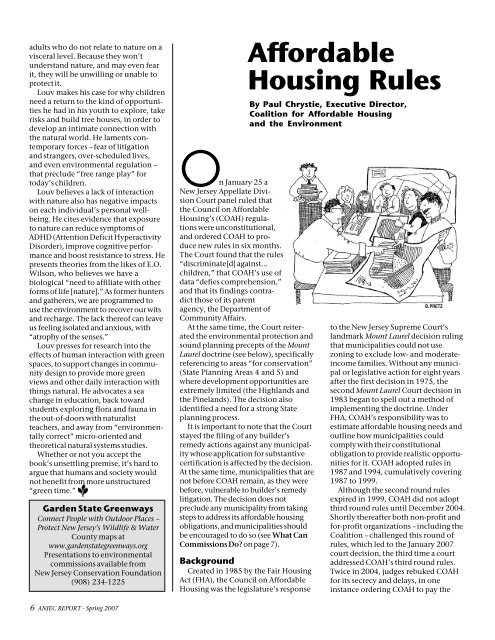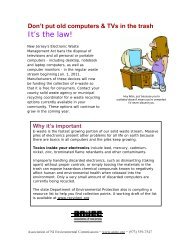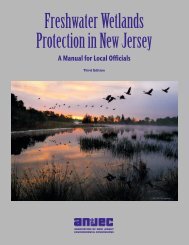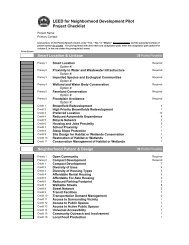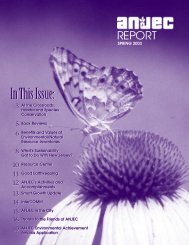In This Issue
Municipal Regulatory Powers in Category One Stream ... - ANJEC
Municipal Regulatory Powers in Category One Stream ... - ANJEC
Create successful ePaper yourself
Turn your PDF publications into a flip-book with our unique Google optimized e-Paper software.
adults who do not relate to nature on a<br />
visceral level. Because they won’t<br />
understand nature, and may even fear<br />
it, they will be unwilling or unable to<br />
protect it.<br />
Louv makes his case for why children<br />
need a return to the kind of opportunities<br />
he had in his youth to explore, take<br />
risks and build tree houses, in order to<br />
develop an intimate connection with<br />
the natural world. He laments contemporary<br />
forces – fear of litigation<br />
and strangers, over-scheduled lives,<br />
and even environmental regulation –<br />
that preclude “free range play” for<br />
today’s children.<br />
Louv believes a lack of interaction<br />
with nature also has negative impacts<br />
on each individual’s personal wellbeing.<br />
He cites evidence that exposure<br />
to nature can reduce symptoms of<br />
ADHD (Attention Deficit Hyperactivity<br />
Disorder), improve cognitive performance<br />
and boost resistance to stress. He<br />
presents theories from the likes of E.O.<br />
Wilson, who believes we have a<br />
biological “need to affiliate with other<br />
forms of life [nature].” As former hunters<br />
and gatherers, we are programmed to<br />
use the environment to recover our wits<br />
and recharge. The lack thereof can leave<br />
us feeling isolated and anxious, with<br />
“atrophy of the senses.”<br />
Louv presses for research into the<br />
effects of human interaction with green<br />
spaces, to support changes in community<br />
design to provide more green<br />
views and other daily interaction with<br />
things natural. He advocates a sea<br />
change in education, back toward<br />
students exploring flora and fauna in<br />
the out-of-doors with naturalist<br />
teachers, and away from “environmentally<br />
correct” micro-oriented and<br />
theoretical natural systems studies.<br />
Whether or not you accept the<br />
book’s unsettling premise, it’s hard to<br />
argue that humans and society would<br />
not benefit from more unstructured<br />
“green time.”<br />
Garden State Greenways<br />
Connect People with Outdoor Places –<br />
Protect New Jersey’s Wildlife & Water<br />
County maps at<br />
www.gardenstategreenways.org<br />
Presentations to environmental<br />
commissions available from<br />
New Jersey Conservation Foundation<br />
(908) 234-1225<br />
Affordable<br />
Housing Rules<br />
On January 25 a<br />
New Jersey Appellate Division<br />
Court panel ruled that<br />
the Council on Affordable<br />
Housing’s (COAH) regulations<br />
were unconstitutional,<br />
and ordered COAH to produce<br />
new rules in six months.<br />
The Court found that the rules<br />
“discriminate[d] against...<br />
children,” that COAH’s use of<br />
data “defies comprehension,”<br />
and that its findings contradict<br />
those of its parent<br />
agency, the Department of<br />
Community Affairs.<br />
At the same time, the Court reiterated<br />
the environmental protection and<br />
sound planning precepts of the Mount<br />
Laurel doctrine (see below), specifically<br />
referencing to areas “for conservation”<br />
(State Planning Areas 4 and 5) and<br />
where development opportunities are<br />
extremely limited (the Highlands and<br />
the Pinelands). The decision also<br />
identified a need for a strong State<br />
planning process.<br />
It is important to note that the Court<br />
stayed the filing of any builder’s<br />
remedy actions against any municipality<br />
whose application for substantive<br />
certification is affected by the decision.<br />
At the same time, municipalities that are<br />
not before COAH remain, as they were<br />
before, vulnerable to builder’s remedy<br />
litigation. The decision does not<br />
preclude any municipality from taking<br />
steps to address its affordable housing<br />
obligations, and municipalities should<br />
be encouraged to do so (see What Can<br />
Commissions Do? on page 7).<br />
Background<br />
Created in 1985 by the Fair Housing<br />
Act (FHA), the Council on Affordable<br />
Housing was the legislature’s response<br />
By Paul Chrystie, Executive Director,<br />
Coalition for Affordable Housing<br />
and the Environment<br />
B. PRETZ<br />
to the New Jersey Supreme Court’s<br />
landmark Mount Laurel decision ruling<br />
that municipalities could not use<br />
zoning to exclude low- and moderateincome<br />
families. Without any municipal<br />
or legislative action for eight years<br />
after the first decision in 1975, the<br />
second Mount Laurel Court decision in<br />
1983 began to spell out a method of<br />
implementing the doctrine. Under<br />
FHA, COAH’s responsibility was to<br />
estimate affordable housing needs and<br />
outline how municipalities could<br />
comply with their constitutional<br />
obligation to provide realistic opportunities<br />
for it. COAH adopted rules in<br />
1987 and 1994, cumulatively covering<br />
1987 to 1999.<br />
Although the second round rules<br />
expired in 1999, COAH did not adopt<br />
third round rules until December 2004.<br />
Shortly thereafter both non-profit and<br />
for-profit organizations – including the<br />
Coalition – challenged this round of<br />
rules, which led to the January 2007<br />
court decision, the third time a court<br />
addressed COAH’s third round rules.<br />
Twice in 2004, judges rebuked COAH<br />
for its secrecy and delays, in one<br />
instance ordering COAH to pay the<br />
6 ANJEC REPORT - Spring 2007


